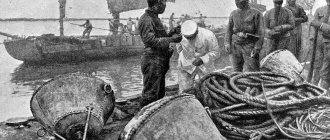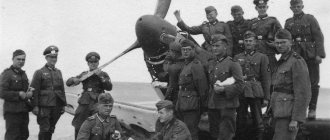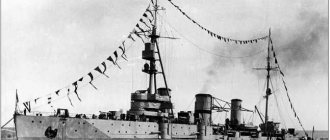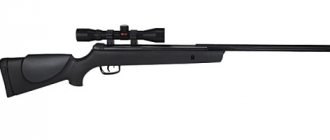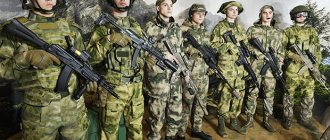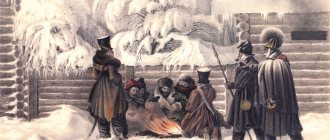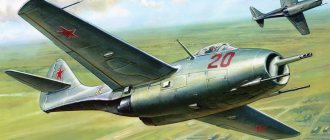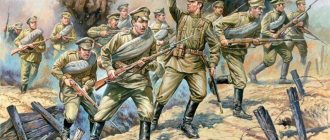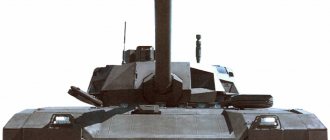Work on mistakes
The defeat in the battle near the port of Coronel greatly damaged the prestige of the Royal Navy. Rear Admiral Doveton Sturdy was declared responsible for the gross strategic errors and unclear instructions. He was also accused of the loss of three cruisers to one German submarine. The place of First Sea Lord was taken by Admiral John "Jackie" Fisher, who could not stand Sturdy. In order not to renew the old enmity, John Fisher decided to give the rear admiral a chance to atone. The British wanted to get even with the Germans for their defeat. Doveton Sturdy became the commander-in-chief of the squadron to search and destroy the German squadron of Maximilian von Spee. John Fisher, under his own responsibility, allocated the newest ships of the fleet - the battlecruisers HMS Inflexible and HMS Invincible, which became the striking force of the squadron.
0
See all photos in the gallery
Battlecruiser HMS Inflexible.
×
The mistakes made under Coronel were taken into account. Realizing that the competent naval commander von Spee would not allow himself to be driven into a trap, the British gathered all their available forces. More than 30 ships of the Grand Fleet and several Japanese cruisers were used to block and intercept the German squadron.
Von Spee's main mistake
The victorious squadron of Count Maximilian von Spee approached the shores of Chile, which remained neutral. Since neutral countries could not accept more than three ships from the warring parties, the squadron had to split up. Scharnhorst, Gneisenau and Nürnberg settled in the port of Valparaiso, while Leipzig and Dresden went to Mas e Fuera. While “resting” in Chilean waters, Spee received information about an approaching Japanese squadron. It became immediately clear that the British were thirsty for revenge. The command ordered Spee to return to his homeland, but the admiral understood that the British would do everything to prevent this.
0
Armored cruiser SMS Scharnhorst.
Spee's squadron delayed to replenish ammunition and fuel. At this time, a message came from Berlin that the German fleet would assist in the breakthrough across the Atlantic. In addition, the vice admiral received information that the British formation had left the waters and headed for South Africa. Considering that the way home was clear, German ships left Chilean ports on November 15.
0
The German squadron before leaving in the port of Valparaiso, Chile.
Due to a severe storm and lack of fuel, the German squadron was able to circumnavigate South America only on December 1st. 5 days later, a meeting was held on board the flagship of the Scharnhorst squadron, where Spee briefed the commanders on further plans. The admiral, having erroneous intelligence about the location of English ships, planned to shell the port of the Falkland Islands and capture the governor. The captain of the Gneisenau, Julius Merker, did not want to go to the Falklands, believing that the available intelligence was misinformation. Despite the objections, the admiral still decided to launch a raid. The operation was scheduled for December 8th. This mistake decided the fate of the German squadron...
Notes[edit]
Memorial plaque to the 8 lives lost from HMS Kent
at Canterbury Cathedral
- Jakes. Dictionary of battles and sieges
. item 346. - Scott and Robertson. Many were delayed by sea: the tragic sinking of HMS Otranto
. paragraph 16. - "8 December: Battle of the Falkland Islands". History.com This Day in History. Retrieved December 5, 2022.
- ^ B Battle of the Falklands - names three German auxiliary ships and states, Bristol
and
Macedonia
sank Colliers
Baden
and
Santa Isabel
, while "another miner",
Seydlitz
, escaped. -
www.worldwar1.co.uk
, accessed 7 December 2022 G. - ^ abc Battle of the Falkland Islands - SS Seydlitz
listed as a "hospital ship" -
www.britishbattles.com
, accessed 7 December 2022 - Massey, 2004, p. 237, citing Pitt pp. 66–67.
- Massey, 2004, pp. 251-52
- Massey, 2004, pp. 253-56
- Massey, 2004, p. 248
- Massey, 2004, p. 249
- Massey, 2004, pp. 249-51
- "United Empire". 14
. 1923: 687. Quote journal requires |journal=(help) - ↑
Ian J. Strange (1983).
Falkland Islands
. David and Charles. item 100. ISBN 0715385313. - Paul G. Halpern (1995). A Naval History of the First World War
. Naval Institute Publishing House. paragraph 99. ISBN 1557503524. - "No. 30576". London Gazette
(Supplement). March 15, 1918 p. 3287. - “... the prospects if the Germans struck back without delay were far from pleasant.” Corbett, J. S. Official History of Great Britain - Naval Operations.
(London: HM Chancery, 1921) Vol. I, Chapter XXIX, quoted in: Baldwin, Hanson W.
The First World War: A Brief History.
(New York: Grove Press, 1962) p. 46 - Regan, Geoffrey. War Jokes (1992) p. 13 Guinness Publishing ISBN 0-85112-519-0
- Regan page 14
- ^ ab Franz von Rintelen (in English). Dark Invader: Wartime Memoirs of a German Naval Intelligence Officer
(1998 ed.). Rutledge. P. 326. ISBN 0714647926. - Jump up
↑ Halpern, p. 97 - Massey, 2004, p. 255
- Beasley, Patrick (1982). Hall 40
. London: Hamish Hamilton Ltd., pp. 77–78. ISBN 0241108640. - "German WWI wreck" Scharnhorst "discovered off Falklands". BBC News
. December 5, 2022. Retrieved December 5, 2022.
Grand Fleet goes hunting
While Spee's squadron was in port, the Grand Fleet was building up its forces. HMS Invincible and HMS Inflexible set sail on 11 November. On November 24, a German radio message was intercepted. The British learned about the location of the German squadron. But this information did not surprise the British, since the Admiralty assumed the possibility of a German attack on the Falklands. 2 days later, two British squadrons, Rear Admiral Sturdee and Rear Admiral Stoddart, united into a powerful “fist”. On November 28, English ships set sail for the islands. The firing exercises conducted the next day cast some doubts about the combat effectiveness of the new ships. In 32 salvoes, Invincible hit the target only once, Inflexible three times. In addition, the Invincible's propellers became entangled in the tow rope. Instead of the planned December 3, the English squadron arrived in the Falkland Islands only on December 7. At 8 am the next day, a message came from the observation post about the discovery of two German ships. The ships of the Grand Fleet immediately put to sea.
Links[edit]
- Bennett, Geoffrey (1962). Coronel and the Falkland Islands
. London: BT Batsford Ltd. - Jacques, Tony (2007). A Dictionary of Battles and Sieges: A Guide to 8,500 Battles from Antiquity to the Twenty-First Century
. Greenwood Publishing Group. ISBN 9780313335389. - Massey, Robert K. (2004). Castles of Steel: Britain, Germany and Victory in the Great War at Sea
. London: Cape Jonathan. ISBN 0-224-04092-8. - Irving, John (1927). Coronel and the Falkland Islands
. London: AM Philpot, ltd. - Halpern, Paul (1994). A Naval History of the First World War
. USA: US Naval Institute. ISBN 1-85728-295-7. - Michael McNally (2012). Coronel and Falklands, 1914;
Duel in the South Atlantic . The Osprey Campaign, Edition No. 248. Osprey Publishing. ISBN 9781849086745 - Scott, R. Neil (2012). Many were delayed by sea: the tragic sinking of HMS Otranto
. Rowman and Littlefield. ISBN 9781442213425. - von Rietelen, Franz (1933). Dark Invader
. London: Bodley Head/Penguin Books.
Long-awaited meeting
At 5 o'clock in the morning on December 8, von Spee's squadron entered the waters and prepared for the operation. At 8:50 the lead ship Gneisenau saw smoke, and soon the masts and chimneys of the English ships. It became clear that all information about the movements of the Grand Fleet ships was false. The ship's commander did not believe that there were battlecruisers in front of him, and reported contact with armored cruisers. Vice Admiral Spee, knowing that armored cruisers did not pose a serious threat, decided to continue moving. 20 minutes later, the first salvo of 305-mm guns from the battery of the battleship Canopus thundered. The Gneisenau, having become a target, turned sharply to the east. The rest of the ships of the German squadron followed him. Spee decided not to accept the battle and ordered the ships to retreat.
0
English battleships and light cruisers in pursuit of the German squadron.
The British, without wasting a second, began the pursuit. Doveton Sturdy knew that sooner or later the British battlecruisers would catch up with the Germans. At 12:40, HMS Invincible and HMS Inflexible approached within salvo range. But Spee turned away from the English squadron so that the wind began to hit the ships directly in the nose. The smoke made it noticeably more difficult for the English squadron to fire: in 20 salvos the British failed to score any hits. But Admiral Spee understood that the pursuit would sooner or later end in battle. He gave the only possible order: light cruisers should leave, and armored cruisers should take the fight. Scharnhorst and Gneisenau turned around and headed northeast. "Nuremberg", "Dresden" and "Leipzig" headed south. Rear Admiral Sturdy foresaw this course of events. Glasgow, Kent and Cornwall were sent in pursuit of the light cruisers. "Scharnhorst" and "Gneisenau" were met by "Invincible", "Inflexible" and "Carnarvon".
Heavyweight fight
At 13:20, Invincible fired a salvo at Gneisenau, Inflexible fired at Scharnhorst. After 20 minutes, Invincible, which had closed the distance, received its first damage. The British increased the distance, after which the battle subsided. After a short pause, the British again forced the battle. The German admiral gave a desperate order - Gneisenau and Scharnhorst went to meet the English cruisers. In addition to 210 mm guns, the Germans were able to use 150 mm guns.
0
"Scharnhorst" and "Gneisenau" are fighting with British cruisers. Painting by William Lionel Wiley.
But the advantages of Invincible and Inflexilb became obvious. Their 305 mm guns left no chance for the German ships. The Gneisenau received serious damage and began to list. The Scharnhorst was burning in several places, and the admiral's flag was shot down. Seeing the absence of the flag, the captain of the Gneisenau, Julius Merker, asked: “Is the admiral alive?” Maximilian von Spee reassured the captain and admitted his mistake made at the meeting. The volleys of English guns did not subside. German shells could not harm the British battlecruisers. At 15:40, Vice Admiral von Spee gave his last order. Under fire from British guns at 16:17, the flagship Scharnhorst capsized and disappeared under water. 760 people died in the icy water, including Admiral Count Maximilian von Spee.
0
"Gneisenau" continued the battle. The ship deftly disappeared into the smoke, and it began to rain. But this only delayed the death of the German cruiser. “Invincible” stood alone against the “German”. But soon two other cruisers came to the rescue, which decided the fate of the Gneisenau. At 17:30 Julius Merker gave the order to stop the ship. The doomed cruiser, without lowering the flag, continued to “snarl” with the help of 150 mm guns. At 17:50 the Gneisenau tilted heavily and the British guns fell silent. Within 10 minutes the German ship sank and the British began a rescue operation. They managed to save 187 people. Julius Merker shared the fate of his ship.
0
HMS Inflexible rescues the survivors of SMS Gneisenau. la
Battle of the light cruisers
The battle of the light cruisers was no less dramatic. The British concentrated their attention on Leipzig. At 16:00, the Glasgow caught up with the German cruiser and began to engage it with 102 mm guns. A little later, other English light cruisers opened fire. Despite the unequal forces, Leipzig continued the battle until 20:00. When the shells ran out, the Germans opened the seacocks and gathered on the deck. Without lowering the flag, Leipzig went under water an hour and a half later. British ships were able to save only 18 sailors. While Leipzig was fighting an unequal battle, Nuremberg was trying to get away from Kent. But due to engine wear, the German cruiser lost speed and became an easy target for the “British”. At 18:25, the Nuremberg stopped and lowered its flag half an hour later. At 19:30 the German cruiser sank. Only 7 people were able to escape. Only Dresden managed to escape the chase. However, a new hunt was organized for it, and in March 1915 it was scuttled by the cruisers Glasgow and Kent.
Result[edit]
HMS " Inflexible"
picks up German sailors from
Gneisenau
after the battle
Casualties and damage were extremely disproportionate; The British suffered very lightly. Admiral Spee and his two sons were among the German dead. The rescued German survivors, 215 in all, became prisoners on British ships. Most of them were from Gneisenau
, nine from
Nuremberg
and 18 from
Leipzig
.
Scharnhorst
was lost with all hands.
One of Gneisenau
's officers who lived on were the only survivors of three different guns on the wrecked cruiser. He was pulled from the water, claiming to be the cousin of the British commander (Stoddart). [18]
Of the known German force of eight ships, two escaped: the auxiliary Seydlitz
and the light cruiser
Dresden
, which roamed free for another three months before its captain was cornered by the British squadron (
Kent
,
Glasgow
and
Orama
) off
the ship
Juan Fernández.
islands on 14 March 1915. After fighting a short battle, the Dresden
captain evacuated his ship and scuttled her, exploding the main ammunition magazine.
As a result of the battle, the German East Asia Squadron, Germany's only permanent naval unit, effectively ceased to exist. An end was put to commercial raids on the high seas by regular Kaiserliche Marine warships. However, Germany placed several armed merchant ships into service as mercantile raiders for the rest of the war (for example, see Felix von Luckner).
